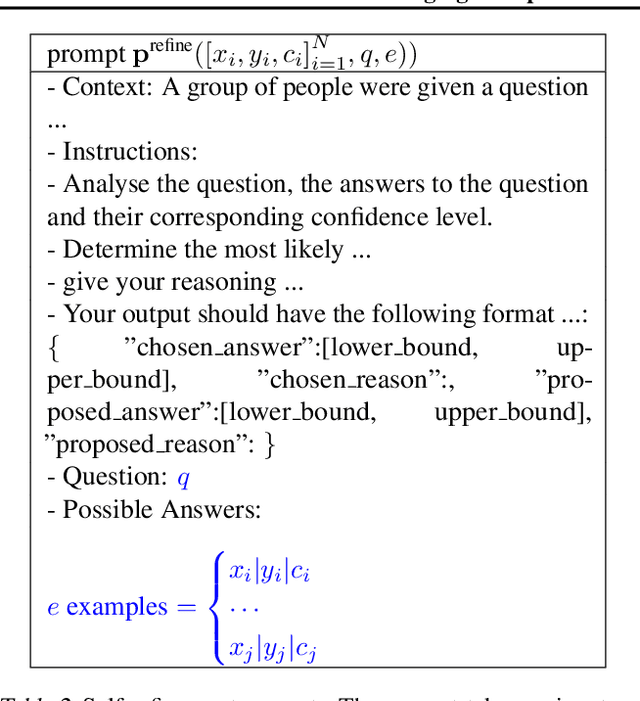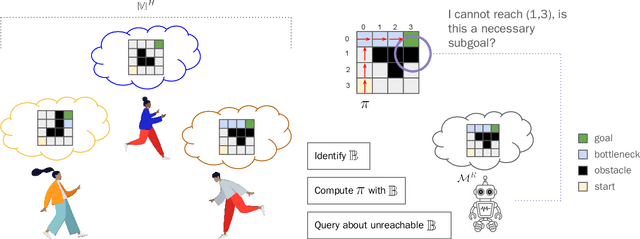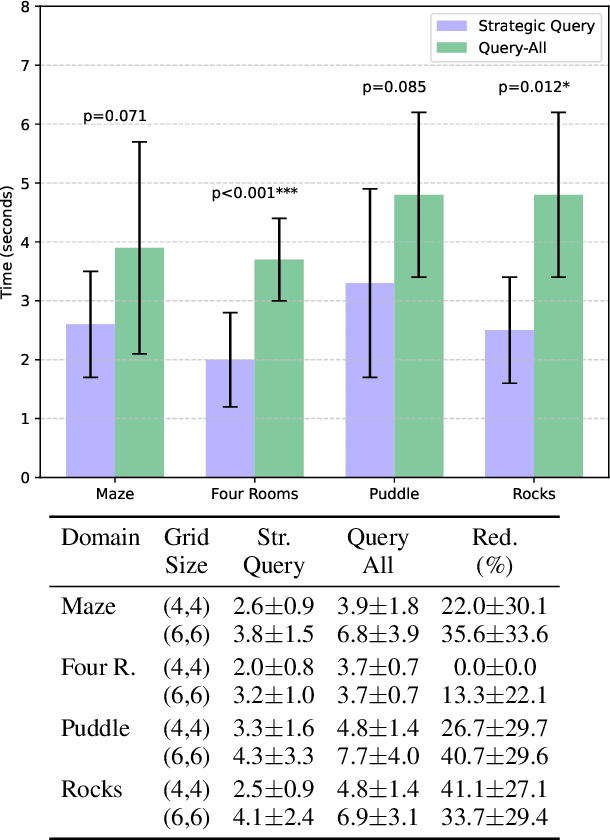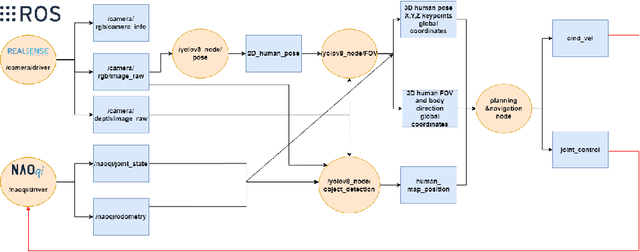Mohamed Chetouani
Controlling Intent Expressiveness in Robot Motion with Diffusion Models
Oct 14, 2025



Abstract:Legibility of robot motion is critical in human-robot interaction, as it allows humans to quickly infer a robot's intended goal. Although traditional trajectory generation methods typically prioritize efficiency, they often fail to make the robot's intentions clear to humans. Meanwhile, existing approaches to legible motion usually produce only a single "most legible" trajectory, overlooking the need to modulate intent expressiveness in different contexts. In this work, we propose a novel motion generation framework that enables controllable legibility across the full spectrum, from highly legible to highly ambiguous motions. We introduce a modeling approach based on an Information Potential Field to assign continuous legibility scores to trajectories, and build upon it with a two-stage diffusion framework that first generates paths at specified legibility levels and then translates them into executable robot actions. Experiments in both 2D and 3D reaching tasks demonstrate that our approach produces diverse and controllable motions with varying degrees of legibility, while achieving performance comparable to SOTA. Code and project page: https://legibility-modulator.github.io.
I-FailSense: Towards General Robotic Failure Detection with Vision-Language Models
Sep 19, 2025Abstract:Language-conditioned robotic manipulation in open-world settings requires not only accurate task execution but also the ability to detect failures for robust deployment in real-world environments. Although recent advances in vision-language models (VLMs) have significantly improved the spatial reasoning and task-planning capabilities of robots, they remain limited in their ability to recognize their own failures. In particular, a critical yet underexplored challenge lies in detecting semantic misalignment errors, where the robot executes a task that is semantically meaningful but inconsistent with the given instruction. To address this, we propose a method for building datasets targeting Semantic Misalignment Failures detection, from existing language-conditioned manipulation datasets. We also present I-FailSense, an open-source VLM framework with grounded arbitration designed specifically for failure detection. Our approach relies on post-training a base VLM, followed by training lightweight classification heads, called FS blocks, attached to different internal layers of the VLM and whose predictions are aggregated using an ensembling mechanism. Experiments show that I-FailSense outperforms state-of-the-art VLMs, both comparable in size and larger, in detecting semantic misalignment errors. Notably, despite being trained only on semantic misalignment detection, I-FailSense generalizes to broader robotic failure categories and effectively transfers to other simulation environments and real-world with zero-shot or minimal post-training. The datasets and models are publicly released on HuggingFace (Webpage: https://clemgris.github.io/I-FailSense/).
Gauging Overprecision in LLMs: An Empirical Study
Apr 16, 2025



Abstract:Recently, overconfidence in large language models (LLMs) has garnered considerable attention due to its fundamental importance in quantifying the trustworthiness of LLM generation. However, existing approaches prompt the \textit{black box LLMs} to produce their confidence (\textit{verbalized confidence}), which can be subject to many biases and hallucinations. Inspired by a different aspect of overconfidence in cognitive science called \textit{overprecision}, we designed a framework for its study in black box LLMs. This framework contains three main phases: 1) generation, 2) refinement and 3) evaluation. In the generation phase we prompt the LLM to generate answers to numerical questions in the form of intervals with a certain level of confidence. This confidence level is imposed in the prompt and not required for the LLM to generate as in previous approaches. We use various prompting techniques and use the same prompt multiple times to gauge the effects of randomness in the generation process. In the refinement phase, answers from the previous phase are refined to generate better answers. The LLM answers are evaluated and studied in the evaluation phase to understand its internal workings. This study allowed us to gain various insights into LLM overprecision: 1) LLMs are highly uncalibrated for numerical tasks 2) {\color{blue}there is no correlation between the length of the interval and the imposed confidence level, which can be symptomatic of a a) lack of understanding of the concept of confidence or b) inability to adjust self-confidence by following instructions}, {\color{blue}3)} LLM numerical precision differs depending on the task, scale of answer and prompting technique {\color{blue}4) Refinement of answers doesn't improve precision in most cases}. We believe this study offers new perspectives on LLM overconfidence and serves as a strong baseline for overprecision in LLMs.
Reasoning LLMs for User-Aware Multimodal Conversational Agents
Apr 02, 2025Abstract:Personalization in social robotics is critical for fostering effective human-robot interactions, yet systems often face the cold start problem, where initial user preferences or characteristics are unavailable. This paper proposes a novel framework called USER-LLM R1 for a user-aware conversational agent that addresses this challenge through dynamic user profiling and model initiation. Our approach integrates chain-of-thought (CoT) reasoning models to iteratively infer user preferences and vision-language models (VLMs) to initialize user profiles from multimodal inputs, enabling personalized interactions from the first encounter. Leveraging a Retrieval-Augmented Generation (RAG) architecture, the system dynamically refines user representations within an inherent CoT process, ensuring contextually relevant and adaptive responses. Evaluations on the ElderlyTech-VQA Bench demonstrate significant improvements in ROUGE-1 (+23.2%), ROUGE-2 (+0.6%), and ROUGE-L (+8%) F1 scores over state-of-the-art baselines, with ablation studies underscoring the impact of reasoning model size on performance. Human evaluations further validate the framework's efficacy, particularly for elderly users, where tailored responses enhance engagement and trust. Ethical considerations, including privacy preservation and bias mitigation, are rigorously discussed and addressed to ensure responsible deployment.
VIPER: Visual Perception and Explainable Reasoning for Sequential Decision-Making
Mar 19, 2025Abstract:While Large Language Models (LLMs) excel at reasoning on text and Vision-Language Models (VLMs) are highly effective for visual perception, applying those models for visual instruction-based planning remains a widely open problem. In this paper, we introduce VIPER, a novel framework for multimodal instruction-based planning that integrates VLM-based perception with LLM-based reasoning. Our approach uses a modular pipeline where a frozen VLM generates textual descriptions of image observations, which are then processed by an LLM policy to predict actions based on the task goal. We fine-tune the reasoning module using behavioral cloning and reinforcement learning, improving our agent's decision-making capabilities. Experiments on the ALFWorld benchmark show that VIPER significantly outperforms state-of-the-art visual instruction-based planners while narrowing the gap with purely text-based oracles. By leveraging text as an intermediate representation, VIPER also enhances explainability, paving the way for a fine-grained analysis of perception and reasoning components.
Inferring Implicit Goals Across Differing Task Models
Jan 29, 2025

Abstract:One of the significant challenges to generating value-aligned behavior is to not only account for the specified user objectives but also any implicit or unspecified user requirements. The existence of such implicit requirements could be particularly common in settings where the user's understanding of the task model may differ from the agent's estimate of the model. Under this scenario, the user may incorrectly expect some agent behavior to be inevitable or guaranteed. This paper addresses such expectation mismatch in the presence of differing models by capturing the possibility of unspecified user subgoal in the context of a task captured as a Markov Decision Process (MDP) and querying for it as required. Our method identifies bottleneck states and uses them as candidates for potential implicit subgoals. We then introduce a querying strategy that will generate the minimal number of queries required to identify a policy guaranteed to achieve the underlying goal. Our empirical evaluations demonstrate the effectiveness of our approach in inferring and achieving unstated goals across various tasks.
A multilingual training strategy for low resource Text to Speech
Sep 02, 2024



Abstract:Recent speech technologies have led to produce high quality synthesised speech due to recent advances in neural Text to Speech (TTS). However, such TTS models depend on extensive amounts of data that can be costly to produce and is hardly scalable to all existing languages, especially that seldom attention is given to low resource languages. With techniques such as knowledge transfer, the burden of creating datasets can be alleviated. In this paper, we therefore investigate two aspects; firstly, whether data from social media can be used for a small TTS dataset construction, and secondly whether cross lingual transfer learning (TL) for a low resource language can work with this type of data. In this aspect, we specifically assess to what extent multilingual modeling can be leveraged as an alternative to training on monolingual corporas. To do so, we explore how data from foreign languages may be selected and pooled to train a TTS model for a target low resource language. Our findings show that multilingual pre-training is better than monolingual pre-training at increasing the intelligibility and naturalness of the generated speech.
Upgrading Pepper Robot s Social Interaction with Advanced Hardware and Perception Enhancements
Sep 02, 2024



Abstract:In this paper, we propose hardware and software enhancements for the Pepper robot to improve its human-robot interaction capabilities. This includes the integration of an NVIDIA Jetson GPU to enhance computational capabilities and execute real time algorithms, and a RealSense D435i camera to capture depth images, as well as the computer vision algorithms to detect and localize the humans around the robot and estimate their body orientation and gaze direction. The new stack is implemented on ROS and is running on the extended Pepper hardware, and the communication with the robot s firmware is done through the NAOqi ROS driver API. We have also collected a MoCap dataset of human activities in a controlled environment, together with the corresponding RGB-D data, to validate the proposed perception algorithms.
Legibot: Generating Legible Motions for Service Robots Using Cost-Based Local Planners
Apr 07, 2024Abstract:With the increasing presence of social robots in various environments and applications, there is an increasing need for these robots to exhibit socially-compliant behaviors. Legible motion, characterized by the ability of a robot to clearly and quickly convey intentions and goals to the individuals in its vicinity, through its motion, holds significant importance in this context. This will improve the overall user experience and acceptance of robots in human environments. In this paper, we introduce a novel approach to incorporate legibility into local motion planning for mobile robots. This can enable robots to generate legible motions in real-time and dynamic environments. To demonstrate the effectiveness of our proposed methodology, we also provide a robotic stack designed for deploying legibility-aware motion planning in a social robot, by integrating perception and localization components.
Utility-based Adaptive Teaching Strategies using Bayesian Theory of Mind
Sep 29, 2023Abstract:Good teachers always tailor their explanations to the learners. Cognitive scientists model this process under the rationality principle: teachers try to maximise the learner's utility while minimising teaching costs. To this end, human teachers seem to build mental models of the learner's internal state, a capacity known as Theory of Mind (ToM). Inspired by cognitive science, we build on Bayesian ToM mechanisms to design teacher agents that, like humans, tailor their teaching strategies to the learners. Our ToM-equipped teachers construct models of learners' internal states from observations and leverage them to select demonstrations that maximise the learners' rewards while minimising teaching costs. Our experiments in simulated environments demonstrate that learners taught this way are more efficient than those taught in a learner-agnostic way. This effect gets stronger when the teacher's model of the learner better aligns with the actual learner's state, either using a more accurate prior or after accumulating observations of the learner's behaviour. This work is a first step towards social machines that teach us and each other, see https://teacher-with-tom.github.io.
 Add to Chrome
Add to Chrome Add to Firefox
Add to Firefox Add to Edge
Add to Edge